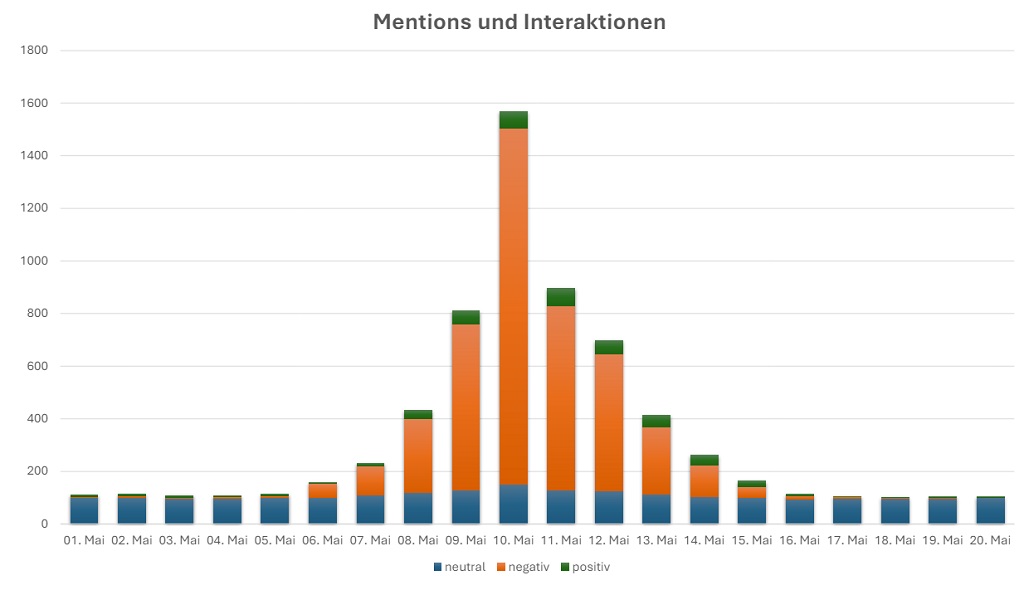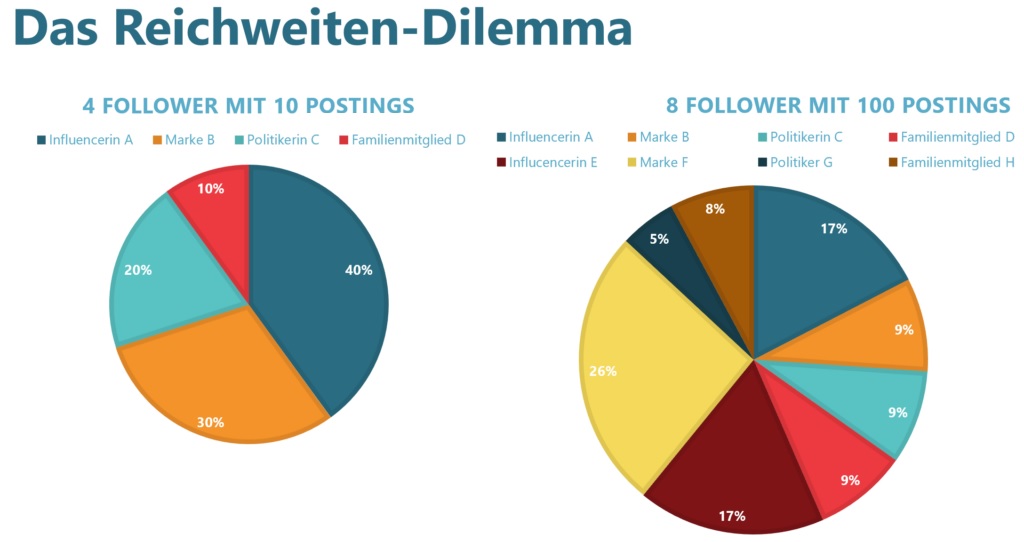Contradictory KPI in online marketing
KPI as a tool in online marketing
Friday, shortly after work. A short message appears on my display: “+100 mentions in the last 4 hours, rising fast.” An alert with a certain urgency. My measurement indicator, which remains completely calm up to 100 mentions per day, has struck. I have set it to ignore the normal daily madness and inform me of any significant changes. Now the number of comments and postings has doubled without further ado – the measuring needle is off, congratulations: KPI achieved. But unfortunately a shitstorm begins…
A threshold value as an important indicator
This threshold value of mentions of the company name may not be a pretty one, but it is a very important indicator. Or should I say an urgent “call to action”? A call to action for me and my team: forget your weekend appointments, the company’s reputation is in acute danger! Get to work quickly, the shitstorm won’t wait until Monday!
Measuring the mentions spoilt our mood, the weekend and a bit of the personnel budget – but it was unquestionably important and useful! The push message didn’t just inform us as a team; it bought us time! We were there “live” as the wave of criticism built up slowly at first and then faster and faster, just like in the textbook. This can usually take a few hours, sometimes even a few days. Time in which we can increase our community management, optimise our FAQ for the current “fail” and think about “countermeasures” – short explanatory videos, short interviews with experts, meaningful facts and figures.
We need to measure in order to optimise
The earlier we recognise that criticism is brewing, the “better”. Because we can react more precisely and manage the consequences better. Because we can utilise our resources in a more targeted manner and focus our communication and marketing measures on a precisely defined goal.
And that’s exactly what KPI are for!
As you know, KPI stands for Key Performance Indicator. However, academically speaking, I consider the two words “key” and “indicator” to be much more important than the pure performance that we measure. Because: We can measure (almost) everything – but not every measurement makes sense and not every measured value is a key to realisation.
- What do we measure?
- How do we measure it?
- Why do we measure it?
We have to ask ourselves these three questions if we want to make meaningful statements. So we ask less about the key indicators, we ask about the measurement itself, about the metric[1].
Thomas Hutter says: “A KPI is a metric, but a metric is not necessarily a KPI! The difference between KPIs and metrics lies in the fact that metrics initially only represent pure data without any context. With a KPI, however, there is a specific question as a guide”[2].
So: What do we need to optimise in our advertising measures so that more people come to our website? What do we need to change in our user guidance so that more people click on other pages? How do we need to design our online shop so that more people buy?
So we change our system independently of a KPI. And then we set ourselves a measuring point at which we can quantify whether the change is successful: 30 per cent more purchases in the next three months. We have defined a key figure. But the measurement itself is not a KPI.
KPI are a tool
Key performance indicators are not an end in themselves, but a tool[3].
- A spirit level does not ensure that our cupboard hangs straight on the wall. We have to drill the holes horizontally ourselves and the spirit level helps us to do this.
- A speedometer does not ensure that we do not drive too fast. But it does help us to keep an eye on our speed and take our foot off the accelerator in good time. The mere number, e.g. 100 km/h, does not help us – we also need to know whether we are on a motorway or a dirt track.
- A thermometer does not tell us whether we have a fever. But it does show us how warm our body is. The measured temperature is a reliable indicator of whether we have a fever or not. Since time immemorial, we have known that an elevated temperature is a sure sign that we are ill – among many other indications.
So we need to define what we want to do. And we need to know how we can achieve it and what the side effects and interactions will be. Then we measure what actually happens.
And only once we have understood this and know the side effects do we set a sensible threshold value and see if, when and how we have reached it. So at the very end of our planning, considerations and optimisations, there is a measured value. That is our KPI. And yes, that’s pretty boring and a banality in itself. And: if a KPI doesn’t help us or needs and can be interpreted at length, then it is not a key performance indicator!
Some KPI are often contradictory
Contradictory key performance indicators are often used in online marketing. Let’s take a look at some of these KPI:
The first is dwell time. It often occurs in complicity with the real non-starter of the KPI literature, the bounce rate. [4] Dwell time measures the exact amount of time users spend on each page. The classic interpretation is: the longer people stay on the page, the better. And the less they leave, the better.
The crazy and therefore contradictory thing about these two KPI is that the exact opposite is also true, depending on your perspective and objectives. Because – as always! – depends on what users want from my offering. Do they want to read my highly interesting, substantial texts and be inspired to browse through my very private crochet blog without any specific search interest and with a lot of muse? Then the following applies: high dwell time, low bounce rate, everything done right. Daniel Hochuli puts it in a nutshell: “Truth: A bounce is a completely normal type of behaviour for someone consuming content”[5].
For a professional, high-turnover online shop, however, the situation can be completely different: The faster users can decide on a product and the quicker they complete the purchase without many clicks, the more satisfied they will be. Speed and targeted, clear navigation are valid satisfaction factors that have a direct impact on sales. And what is more important than satisfied customers and full checkouts?
Speaking of the checkout: if you want to know when the theatre box office opens, for example, you don’t want to have to spend ages looking for the time: open the page, discover the data immediately at the top right, aha, 6.30 pm on Wednesday, great! Perfect user experience with a ridiculously short dwell time and record-breakingly high bounce rate, dear dramaturges! 😊 A drama in four acts would be completely out of place here, a long dwell time is nothing more than a red flashing indicator of poor user guidance!
But if long reading and lots of clicking, long reading and little clicking, short reading and fast clicking are summarised in two KPIs: What use are these KPI to us then?
And what about reach, visibility and interactions?
Two other contradictory KPI are reach and visibility. This is particularly annoying for large influencers and large undertakings. Because the bigger they are, the lower their relative reach. Sounds absurd? Yes, but it’s simple maths: the more followers an influencer or a company has, the more likely the algorithm is to reduce the playout.
Why is that the case? Because we are fortunately not alone in the world! When a platform is new and only a few people post a little, the relative reach of people with many followers and frequent posts is high to very high. However, the more people use the platform and post themselves, the more “clogged” our feed becomes – and the percentage of reach and visibility decreases.
It’s like elections: If I only have two relevant parties, as in the USA, then both get around half of the votes. But if I have 15 parties, then 15 to 25 per cent is already a lot. So I have to put my figures in relation to the competition and the total number. This is banal, but is sometimes forgotten in the heat of the social media battle.
But what do relatively low relative reach figures tell us? The lower, the greater? No, this KPI doesn’t provide us with any real clarity either.
Okay, but interaction rates are clearly meaningful, aren’t they? They’re a sure sign that people are interested in us and our content and want to talk to us – and that’s desirable, isn’t it?
Yes, er, no. It depends again. In normal times and with normal, boring companies, yes. But when that one notification lights up on your smartphone after work on Friday, then you already know… 😉 A shitstorm is nothing more than an interaction event that has got completely out of hand – stupidly combined with an extremely negative sentiment. These KPI ruin any reporting for the next 24 months because you unfortunately have to factor out the fantastic interaction rates and the short-term negative sentiment. In this case, less interaction equates to a positive development for you and your company! And so the interaction rate is not really a convincing key performance indicator either.
Substance beyond contradictory KPI
Working with KPI in online marketing is not as simple and clear-cut as it might seem at first glance. This leads to the question of why we measure so much at all if the interpretations of the results often challenge us?
Let’s be honest: we often know how things are going even without measurement if we engage with our channels and platforms on a daily basis. We recognise what the mood is like, what customers are discussing, what the feedback from users is, what content is particularly well received and how high user engagement is. Simply because we deal with it every day.
Of course, companies can continue to use – even contradictory – KPIs in online marketing as a tool. In my view, however, we should focus more on compelling content far removed from metrics.[6] In my experience, vibrant, colourful, topical and substantive channels thrive. They flourish because of great content and the creative commitment of the channel owners – and not because of the figures set in the annual meeting, which were unfortunately narrowly missed.
Extra bonus
Here you will find 3 additional questions on key performance indicators answered by Harald Ille (please click the plus buttons):
Why shouldn't most KPIs be goals in online marketing?
Harald Ille: Defining KPI as goals only makes sense if you can influence the achievement of the goal – e.g. through money. If you spend 10 per cent more on advertising next month and, with a bit of luck, make 15 per cent more sales.
For all other tasks in online marketing, however, such KPI make no sense. Why not? Because there is no simple relationship between your KPI and your quantitative effort.
Example: You want to have ten per cent more followers in the next six months. Do you then have to work ten per cent better? Or post ten per cent more? Or interact ten per cent more? And what happens if you reach 20 per cent more followers? Do you then halve your engagement again? Do you only reply to half of all comments and leave every second post offline?
Rather than engaging in these kinds of theoretical thought games, you should ask yourself what you can actually do to reach more users. Develop ideas and utilise the experience of colleagues or experts. Instead of formulating quantitative goals, pay attention to the development of follower numbers, for example, and consistently do your best! And do it again and again!
Aren't most KPI in online marketing ambiguous?
Harald Ille:Yes, measured values are always context-dependent. The boiling point of water is different depending on air pressure and altitude.
Let’s take a look at the impressions, for example: We need around seven impressions to be able to achieve any advertising effectiveness at all. But that is only a rough average. One measure works immediately with the first impression, the other has to be repeated for a long time: Carglass repairs…
So what do we need, what do we measure and when have we achieved our goal? Unfortunately, this depends on many factors, and ultimately also a little bit on chance.
Can you do without KPI in online marketing?
Harald Ille: Certainly not because we would then be even more blind than we already are. We have to put the key performance indicators in the right context and analyse this context very carefully. Then we get meaningful pointers. We must not see KPs as a “shortcut” to this strenuous mental effort, but as a signpost. Less KPI, more context, that’s what I would recommend.
[1] Wer nochmal KPI sagt, fliegt raus
[2] Thomas Hutter: Der Unterschied zwischen KPI und Metrik
[3] Zahlen sind (noch) keine Maßnahmen
[4] What is bounce rate?
[5] Daniel Hochuli: 5 bullshit metrics you need to stop using to measure content marketing success
[6] Brauchen wir KPI fuers Intranet
Do you want to convince your customers and not persuade them? Then take a look at Harald Ille’s beautiful website.
If you like the article or want to discuss it, feel free to share it with your network.
Harald Ille has published more posts in the t2informatik Blog:

Harald Ille
Harald Ille is an experienced journalist and university lecturer in public relations (PR). He has worked in PR and corporate communications for local authorities, hospitals and corporations for almost 25 years. As a self-employed “digital enthusiast”, he is passionate about the life-changing opportunities that digital technologies offer us.
In the t2informatik Blog, we publish articles for people in organisations. For these people, we develop and modernise software. Pragmatic. ✔️ Personal. ✔️ Professional. ✔️ Click here to find out more.




